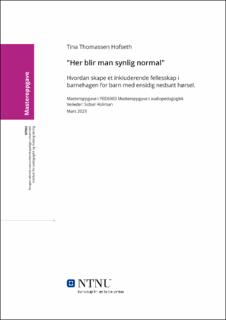| dc.contributor.advisor | Holiman, Sidsel. | |
| dc.contributor.author | Hofseth, Tina Thomassen. | |
| dc.date.accessioned | 2023-06-07T17:19:18Z | |
| dc.date.available | 2023-06-07T17:19:18Z | |
| dc.date.issued | 2023 | |
| dc.identifier | no.ntnu:inspera:138824068:50337395 | |
| dc.identifier.uri | https://hdl.handle.net/11250/3070410 | |
| dc.description.abstract | I dette kvalitative forskningsprosjektet har jeg undersøkt hvordan vi kan skape et inkluderende fellesskap i barnehagen for barn med ensidig nedsatt hørsel. Jeg har intervjuet fire pedagogiske ledere fra ulike barnehager som alle hadde et barn med ensidig nedsatt hørsel på sin avdeling. To av deltakerne hadde erfaringer med barn med nedsatt hørsel fra før, og de to andre jobbet med dette for første gang i 2022. Teorigrunnlaget for oppgaven tar for seg konsekvenser av ensidig nedsatt hørsel, inkludering og ulike dimensjoner ved inkludering, ulike tilretteleggingsmåter, og praksisfellesskapet og lek.
Gjennom analysen av mine funn fant jeg fire tema; tilgang på praksisfellesskapet, støydemping, barnehagens kompetanse, og holdninger. Tilgang på praksisfellesskapet viser til hvordan barnehagen inkluderer barnegruppa med hverandre, og hvilke tiltak de har gjort. For eksempel å dele barnegruppa i mindre grupper, skjerme leken, og komme med støtte i leken er løftet frem som positive tiltak. Støy er en av de største utfordringene for barn med ensidig nedsatt hørsel, som gjør den fysiske tilgangen på fellesskapet utfordrende uten inkludering og tilretteleggingstiltak. Støydemping handler om hva barnehagen gjør for å redusere støyen ut fra sine forutsetninger. Barnehagens kompetanse sier noe om hva barnehagen må ha av kompetanse i arbeidet med inkludering i barnehagen og barn med ensidig nedsatt hørsel. Informasjon om hva som er konsekvensene av ensidig nedsatt hørsel og tilretteleggingstiltak innenfor det fysiske, tekniske, pedagogiske og organisatoriske er avgjørende. Holdninger tar for seg hvilke holdninger personalet i barnehagen har til inkludering og tilretteleggingstiltak. Det rommer også holdninger på nivåene over avdelingen som styrer og barnehageeier. Ved å ha positive holdninger til inkluderingen og å tenke på barnegruppa som et inkluderende fellesskap er noe som kommer tydelig frem.
Konsekvensene av funnene, og forslag til videre forskning, blir også drøftet. | |
| dc.description.abstract | In this qualitativ research project, I have investigated which how to create an inclusive community environment in kindergarten for children with unilateral hearing loss. I have interviewd four pedagogical leaders from different kindergartens, each with a child with unilateral hearing loss in their departments. Two of the participants had previous experience with children with unilateral hearing loss, the other two worked with these children for the first time in 2022. The theoretical basis for this research is focused on the consequences of unilateral hearing loss, inclusiveness and various dimensions of integration, different forms of facilitation, communities of practice and play.
Through the analysis of my findings, I have pinpointed four themes: access to communities of practice, noise reduction, the proficiency of the kindergarten, and attitudes. Access to communities of practice refers to how the kindergarten includes the group of children with each other, and which measures have been put in place. For example, by splitting the children into smaller groups, safe-guarded and supportive play are highlighted as positive measures. Noise is one the greatest challenges for children with unilateral hearing loss, which makes physical access to the group difficult without inclusiveness and facilitative measures Noise reduction is about what the kindergarten does, within its prerequisites, to reduce noise levels. The proficiency of the kindergarten refers to which competences are required in working with inclusiveness both within the kindergarten and with children with unilateral hearing loss. Access to information regarding the consequences of unilateral hearing loss, facilitative measures with respect to the physical, technical, pedagogical, and organizational are decisive. Attitudes refers to which mindset the personnel in the kindergarten have towards inclusiveness and facilitative measures. This also includes the attitudes of those in leadership and the owners of the kindergartens. To have a positive approach towards inclusiveness and viewing the group of children as an inclusive community is something which stands out.
The consequenses of the findings, and proposals for further research, are also discussed. | |
| dc.language | nob | |
| dc.publisher | NTNU | |
| dc.title | "Her blir man synlig normal"
Hvordan skape et inkluderende fellesskap i barnehagen for barn med ensidig nedsatt hørsel. | |
| dc.type | Master thesis | |
